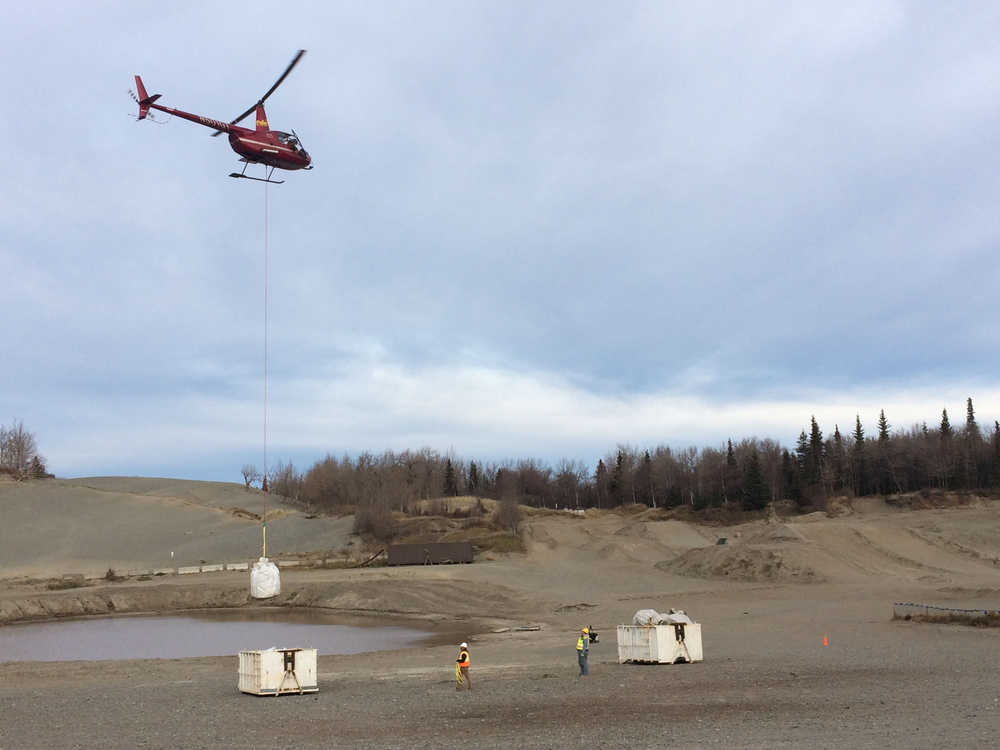ANCHORAGE — The final cleanup is underway in Anchorage after the 1964 Great Alaska Earthquake helped turn a sea-side bluff into an auto junkyard.
Here’s a quick look at how the vehicles got imbedded into the 250-foot cliff overlooking Cook Inlet and directly above a wildlife refuge important for migratory birds, and what’s being done to get some of them out:
How did the problem start?
On Good Friday in 1964, the second most powerful earthquake ever recorded devastated parts of southcentral Alaska, including the then-young city of Anchorage. Debris from downed or damaged downtown buildings left cars unusable.
“At the time, in the 1960s, they brought the vehicles out here to an old gravel pit, crushed them, threw them over the side of a 250-foot high bluff,” said Joe Meehan, the land and refuge manager for the Alaska Department of Fish and Game. The department runs the Anchorage Coastal Wildlife Refuge below the bluff, where thousands of migratory birds stop every year.
Meehan said unwanted sand from the gravel pit also went over the bluff, burying the cars and helping them become part of the bluff in the city’s expansive Kincaid Park.
At least the problem stopped shortly after, right?
No. It was used as a dump site for at least a decade. “The official dumping of vehicles stopped here in the late 1970s after Earth Day and environmental awareness came along,” Meehan said.
It’s estimated that about 2,000 vehicles were dumped over the cliff, legally or illegally.
Well, at least nothing else was thrown over the bluff, right?
No. During the nine-year effort to remove the cars, volunteers and staff members have removed about 2,000 tires and about 100 tons of miscellaneous debris. Meehan says they’ve found “everything under the sun,” from refrigerators to ovens to motorcycles. This is in addition to about 100 vehicles that have been taken out for recycling, but they weren’t all beaters from the 1960s.
“There was a fairly new vehicle, about a 3-year-old vehicle, that had been stolen and thrown over the edge,” Meehan said.
At least there was nothing weird thrown over the bluff, right?
Well, weird is in the eye of the beholder. But Meehan said they have found baby car seats and wheelchairs. Oh, and outhouses.
How are they getting
this stuff out?
Normally they wait until the marsh freezes every winter, and they are able to drive vehicles and heavy machinery on the ice to remove the cars from the bluff.
“Because of the warm winters we’ve been having, the marsh hasn’t frozen and we decided this time around, we’re just going to use a helicopter to slingload all those parts out,” he said.
A private helicopter was hired to fly 16 bags, each weighing about 700 pounds, up the 250-foot tall bluff Wednesday. The helicopter pilot battled high, cold winds to grab the bundles and navigate them to waiting trash bins. From there, the old car parts will be taken to a metal recycler.
Will all 2,000 cars
be removed?
No. They have removed the cars that have reached the bottom of the bluff, near the marsh, to protect the wetlands and wildlife habitat. Plus, there could be bluff damage if they removed the cars, and it would be an expensive endeavor. They are just going to let the cars that remain buried in the bluff to degrade over the centuries.
“Somebody comes back here in 500 years, they probably won’t see anything except for a natural bluff,” Meehan said.
Why bother to clean this up?
Meehan said the goal has been to remove all the garbage and tires and appliances out of the marsh, which serves as an important stop for birds like waterfowl and shorebirds.
He said the refuge is really important for thousands and thousands of migrating birds that come from the Lower 48, Mexico and Central America. The birds head into interior, northern and western Alaska.
Plus by removing the vehicles they can, it helps reduce the possibility of contaminating the marsh because the cars still contain brake and transmission fluids and batteries.
“It’s a unique refuge, to have it right on the outskirts of a major city like Anchorage, and we just want to make sure we manage it appropriately,” Meehan said.

